User-Initialized Active Contour Segmentation and Golden-angle Real-Time Cardiac MRI Enable Accurate Assessment of LV Function in Patients with Sinus Rhythm and Arrhythmias
Contijoch F, Witschey W, Rogers K, Rears H, Hansen MS, Yushkevich PA, Gorman JH III, Gorman RC, Han Y

Background: Data obtained during arrhythmia is retained in real-time cardiovascular magnetic resonance (rt-CMR), but there is limited and inconsistent evidence to show that rt-CMR can accurately assess beat-to-beat variation in left ventricular (LV) function or during an arrhythmia.
Methods: Multi-slice, short axis cine and real-time golden-angle radial CMR data was collected in 22 clinical patients (18 in sinus rhythm and 4 patients with arrhythmia). A user-initialized active contour segmentation (ACS) software was validated via comparison to manual segmentation on clinically accepted software. For each image in the 2D acquisitions, slice volume was calculated and global LV volumes were estimated via summation across the LV using multiple slices. Real-time imaging data was reconstructed using different image exposure times and frame rates to evaluate the effect of temporal resolution on measured function in each slice via ACS. Finally, global volumetric function of ectopic and non-ectopic beats was measured using ACS in patients with arrhythmias.
Results: ACS provides global LV volume measurements that are not significantly different from manual quantification of retrospectively gated cine images in sinus rhythm patients. With an exposure time of 95.2 ms and a frame rate of > 89 frames per second, golden-angle real-time imaging accurately captures hemodynamic function over a range of patient heart rates. In four patients with frequent ectopic contractions, initial quantification of the impact of ectopic beats on hemodynamic function was demonstrated.
Conclusions: User-initialized active contours and golden-angle real-time radial CMR can be used to determine time-varying LV function in patients. These methods will be very useful for the assessment of LV function in patients with frequent arrhythmias.
